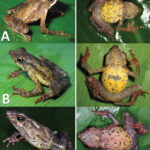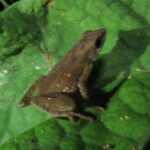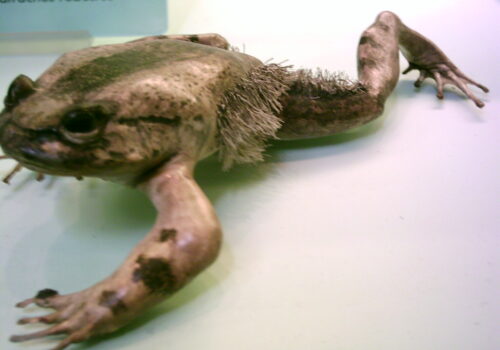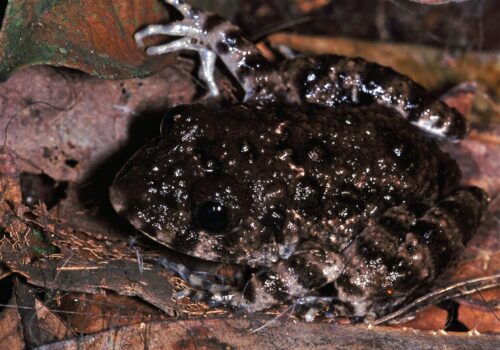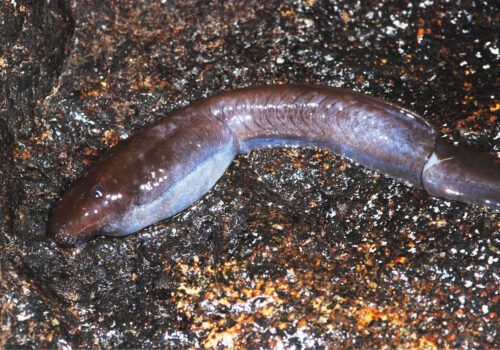Introduction: Unveiling the Mystery of Leptodactylodon perreti#
Deep within the lush shade of Cameroon’s humid mountain forests, hidden amidst carpets of damp leaf litter and moss-covered rocks, lives a species few have encountered—the mysterious frog known as Leptodactylodon perreti. Shy yet captivating, this enigmatic amphibian embodies an essential link within Central Africa’s delicate ecosystem. Scientifically classified in the Arthroleptidae family, it is known as much for its elusive nature as it is for its vulnerability. Each sighting of L. perreti represents a fleeting glimpse into an isolated world of profound ecological significance.
Named after renowned herpetologist Jean-Luc Perret, who dedicated his career to African amphibian research, Leptodactylodon perreti is an unrivaled symbol of biodiversity and conservation urgency. Through its cryptic habits, unique biology, and fragile status, this amphibian offers us insight—not just into its own hidden life—but into the health and vitality of its broader environment.
Taxonomy and Classification#
Leptodactylodon perreti belongs to the family Arthroleptidae, a lineage of frogs collectively known as squeakers, named for their soft chirping vocalizations. Within Arthroleptidae, it occupies the genus Leptodactylodon, where it shares close ancestry with species such as Leptodactylodon ovatus and Leptodactylodon bueanus, often differentiated by subtle morphological details and habitat preferences.
Since its description by renowned amphibian biologist Martin Lamotte in 1972, L. perreti has been distinguished by critical anatomical traits—particularly the unique shape and structure of its fingertips, its webbing characteristics, and the intricate markings and texture on its skin. These subtle distinctions are vital to herpetologists trying to understand biodiversity, distribution, and evolution within this amphibian lineage.
Natural Habitat#
Geographical Distribution and Home Range#
The elusive Leptodactylodon perreti is endemic exclusively to western Cameroon, particularly concentrating around the high-altitude forest habitats of Mount Manengouba, Mount Bamboutos, and surrounding areas. Its restricted range exemplifies the remarkable degree of endemism found within Cameroon’s biodiverse mountain systems, making it an ambassador species that underscores conservation permeability across Cameroon’s fragmented high-altitude ecosystems.
Habitat Preferences and Microhabitat Usage#
Leptodactylodon perreti thrives in damp, shaded montane forests, typically from elevations of around 1200 to 2200 meters above sea level. The habitat is characterized by dense canopy layers, consistent moisture from frequent cloud cover and rainfall, and an understory rich with decomposing organic material, leaf litter, and moss-covered fallen logs. This microhabitat is vital for their breeding and hideaway activities, providing invaluable shelter and sustenance.
At the core of its habitat preference lies proximity to small freshwater streams and seepage areas. Here, amid hidden pools and trickling brooks, L. perreti exhibits its complex life cycle, beginning from egg-laying, through tadpole development, to the cautious emergence of metamorphosed juveniles into adulthood. This amphibian’s reliance on such pristine freshwater habitats highlights the critical importance of freshwater management for conservation claims.
Physical Characteristics#
The striking appearance of Leptodactylodon perreti may not immediately attract attention, yet closer observations reveal vivid adaptations tailored for survival in a secretive life beneath the forest’s canopy. Approximately 40-55mm in length, these frogs possess robust bodies and relatively shorter limbs adapted seamlessly for terrestrial habitats among leaf litter and moss.
Coloration varies subtly between individuals, primarily characterized by a patchwork of deep olive-brown, grey, and russet shades with faint darker markings providing camouflage against leaf litter. The frog’s dorsal skin is granular, providing additional texture that closely mimics decaying plant matter. Such camouflage is instrumental in avoiding predation by birds, snakes, and small mammals frequenting their habitat.
Eyes are large and prominent, reflective of nocturnal and crepuscular activities, giving them an advantage during low-light conditions. Their limbs, strong yet discreet, end in slender, unwebbed digits which facilitate careful navigation across complex terrain rather than swimming efficiency. This morphological adaptation again underlines their terrestrial preferences, despite the presence of nearby freshwater bodies.
Behavior and Life Cycle#
Diet and Feeding Habits#
Leptodactylodon perreti primarily engages in nocturnal foraging, preying opportunistically on insects, spiders, and various arthropods abundant in its secluded forest floor realm. Their diet consists primarily of prey items that venture into their leaf-litter habitat, making them essential natural pest controllers within the forest ecosystem.
Breeding Customs and Reproduction#
Breeding in L. perreti coincides with seasonal patterns of rainfall when streams and seepages expand, providing suitable micro-aquatic habitats essential for egg and tadpole development. Male frogs congregate near these temporary pools where gentle vocalizations, soft chirping reminiscent of tiny birdsong, signal reproductive intent toward potential female mates.
Females deposit clutches of eggs in secluded niches, carefully hidden among moist foliage or attached beneath submerged rocks in shallow, calm waters. Unusually for amphibians, L. perreti tadpoles exhibit semi-terrestrial development, remaining closely connected to moist grounds rather than free-floating extensively. Their adaptation to these microhabitats allows survival in areas vulnerable to drying spells, displaying their ability to adapt, although within limited parameters.
Ecological Role#
As an insectivorous predatory amphibian, Leptodactylodon perreti contributes substantially to the balance of invertebrate populations in its ecological niche. In its prey-predator interactions, it also forms a vital link within the food web, becoming prey for predators like snakes, birds, and small mammals. This intermediate trophic status makes it an excellent indicator species for monitoring ecosystem health and habitat integrity.
The existence and abundance of this species signal the health status of freshwater habitats and adjacent terrestrial environments. Any reduction in numbers or health abnormalities can quickly inform conservationists about potential threats to environmental stability, guiding rapid ecological interventions.
Threats and Conservation Status#
Status and Threat Recognition#
The International Union for Conservation of Nature (IUCN) currently classifies Leptodactylodon perreti as “Endangered,” primarily due to its highly limited distribution, habitat fragmentation, and growing anthropogenic pressures. Habitat loss through deforestation— for agriculture, timber extraction, and expanding human settlements—has been occurring rapidly in Cameroon’s highlands, directly impacting the available suitable habitat required for the species’ survival.
Anthropogenic Challenges: An Indicator Species at Risk#
Climate change represents another perilous threat, leading potentially to alterations in rainfall patterns, reduced stream availability, and harsher temperature fluctuations—all catastrophic for a species relying so profoundly on moist micro-ecosystems. Additionally, pesticide use and pollution in these regions can further exacerbate their vulnerability by harming developmental stages, juveniles, and adult health alike.
Cultural and Scientific Significance#
Though culturally specific legends concerning Leptodactylodon perreti are sparse due to their reclusive behavior and limited visibility, the scientific importance of this amphibian cannot be overstated. Scientists and conservationists eagerly study the species to better understand the dynamics of isolated montane ecosystems, climate sensitivity, disease prevalence in amphibians, and evolutionary patterns shaping biodiversity on a continental scale.
Conclusion: Safeguarding Cameroon’s Hidden Treasure#
The quiet life of Leptodactylodon perreti among Cameroon’s mountain shadows resonates deeply with the essential need for holistic ecological conservation—highlighting intricate biological beauty amidst vulnerability. Protective measures, including habitat preservation, research, and awareness campaigns, are urgently required to ensure its continued existence.
We have the collective responsibility to preserve not only the beauty of Species such as L. perreti but the broader biodiversity upon which our shared future depends. By valuing and acting to protect such delicate, unseen ecosystems, we secure a healthier, richer world for generations to come.


